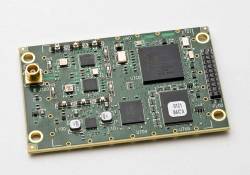 Calgary, Alberta: Canadian high-tech center and home to rivals NovAtel and Hemisphere GPS
Calgary, Alberta: Canadian high-tech center and home to rivals NovAtel and Hemisphere GPSTwo Canadian companies — NovAtel and Hemisphere GPS — that over the years had positioned their products somewhat separately along the GNSS OEM technology spectrum appear to be moving toward a more head-to-head competition.
Two Canadian companies — NovAtel and Hemisphere GPS — that over the years had positioned their products somewhat separately along the GNSS OEM technology spectrum appear to be moving toward a more head-to-head competition.
At the Institute of Navigation ION GNSS 2010 conference in Portland, Oregon, last week (September 21–24), the Calgary, Alberta—based companies announced their next-generation dual-frequency products: NovAtel’s OEM6 GNSS receiver platform and Hemisphere’s miniEclipse GPS/GLONASS board. Both are compact dual-frequency, high-performance, low-power GNSS OEM designs that target system integrators and manufacturers of high-precision user equipment.
Until recently, with its single-frequency code/carrier GPS technology Hemisphere had sought a “sweet spot” between lower-accuracy/lower-cost single-frequency C/A-code GPS module vendors and those with more expensive, high-precision multi-GNSS, dual-frequency offerings.
NovAtel has been a leader among the handful of GNSS manufacturers offering products in the latter category. Other companies competing in that space include Trimble, Topcon, and Javad GNSS.
NovAtel, in particular, has promoted its OEMV-1DF board as the smallest dual-frequency receiver in the marketplace. Now Hemisphere GPS is explicitly aiming at its cross-town neighbors audience, in some cases comparing its miniEclipse receiver’s physical properties and performance with specific NovAtel products.
According to NovAtel, its new OEM6 platform offers comprehensive support for all current and upcoming GNSS constellations and satellite signals including GPS, GLONASS, Galileo, and Compass (Beidou-2). The OEM628 board, the first in the new receiver line, expands positioning capabilities with the inclusion of such features as RAIM (Receiver Autonomous Integrity Monitoring) for safety critical applications, integrated LAN Ethernet port with NTRIP Client, and server capabilities designed for seamless integration into reference network applications, and 100 Hertz measurements for high dynamic positioning.
The OEM628 board is form, fit, and function–compatible with NovAtel’s OEMV-2TM receiver and supports all NovAtel OEM firmware options, including AdVance RTK for centimeter-level positioning accuracy, ALIGN for precise heading determination, GL1DE for consistent pass-to-pass accuracy, and L-band positioning for autonomous decimetre level positioning. The board will be available to order in November 2010, with first shipments occurring in December 2010.
Hemisphere GPS says that the miniEclipse uses the same digital and analog ASIC design as the recently released Eclipse II OEM board. According to the company, the miniEclipse comes in one configuration that makes it the smallest precision dual-frequency (L1/L2) GNSS OEM module available in the market today. The miniEclipse P200 form factor is a drop-in board replacement for Hemisphere GPS’ Crescent board, while miniEclipse P201 is configured as a drop-in replacement for another industry standard interface.
The miniEclipse is scalable, functioning in L1-only, SBAS (satellite-based augmentation system), and RTK modes that can be upgraded to dual-frequency RTK solutions. Also, raw data is available for post-processing in any configuration. P200 and P201 also feature Hemisphere’s patented SureTrack and COAST technologies.
Hemisphere says that both OEM boards will be available in the fourth quarter of 2010 through the company’s global network of dealers.





